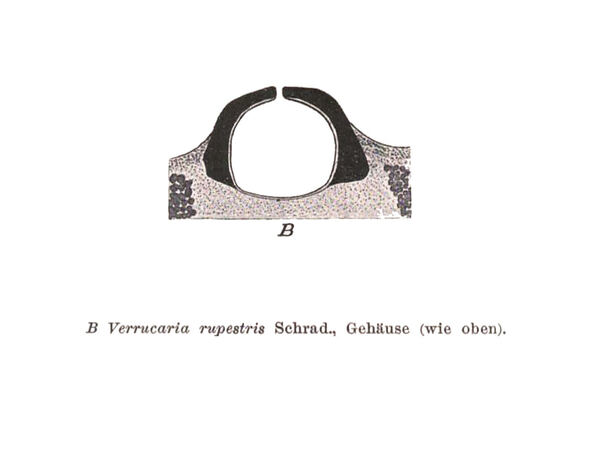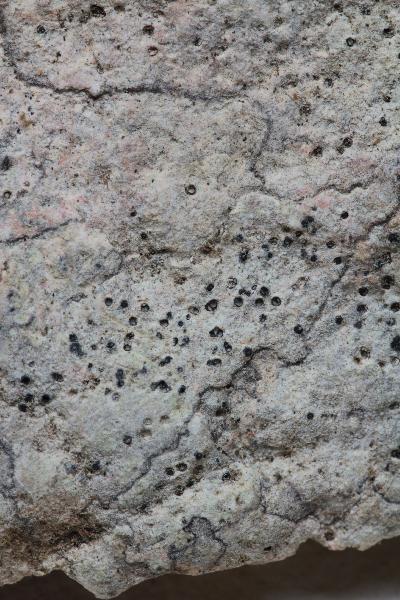Verrucaria rupestris Schrad.
Spicil. Fl. Germ., 1: 109, 1794.
Synonyms: Amphoridium rupestre (Schrad.) A. Massal.
Distribution: N - Ven (Ravera & al. 2022), TAA (Dalla Torre & Sartnthein 1909, Nascimbene & al. 2022), Emil (Fariselli & al. 2020), Lig (GDOR 92).
Description: Thallus crustose, endosubstratic, forming a grey-white to pale brown discoloration on the rock, without a distinct prothallus. Perithecia black, fully immersed in the rock or rarely very slightly projecting only with the up to 0.3 mm wide apical part, leaving pits in the rock when they fall off. Involucrellum black, up to 0.4 mm across, the upper part thick, becoming progressively thinner toward the base, usually encircling the exciple or reaching at least to mid-level; exciple c. 0.3 mm across, the wall dark in upper part, pale in lower part; hamathecium of periphyses and periphysoids, interascal filaments absent; hymenial gel 1+ blue turning reddish. Asci 8-spored, clavate, I-, fissitunicate, the wall thickened above, with an ocular chamber, dehiscent by extrusion of an endotunica to form a delicate rostrum, Verrucaria-type. Ascospores 1-celled, hyaline, oblong-ellipsoid, 17-25 x 9-13 µm. Photobiont chlorococcoid. Spot tests: K-, C-, KC-, P-, UV-. Chemistry: without lichen substances.
Note: an early coloniser of pebbles, mortar walls, brick and roofing tiles, until recently confused with V. muralis, from which it differs in the endolithic thallus and the perithecia which are immersed in the thallus and in the rock; certainly more widespread in Italy, earlier records could be under V. muralis.
Growth form: Crustose
Substrata: rocks
Photobiont: green algae other than Trentepohlia
Reproductive strategy: mainly sexual
Pioneer species
Commonnes-rarity: (info)
Alpine belt: absent
Subalpine belt: absent
Oromediterranean belt: absent
Montane belt: very rare
Submediterranean belt: very rare
Padanian area: absent
Humid submediterranean belt: absent
Humid mediterranean belt: absent
Dry mediterranean belt: absent
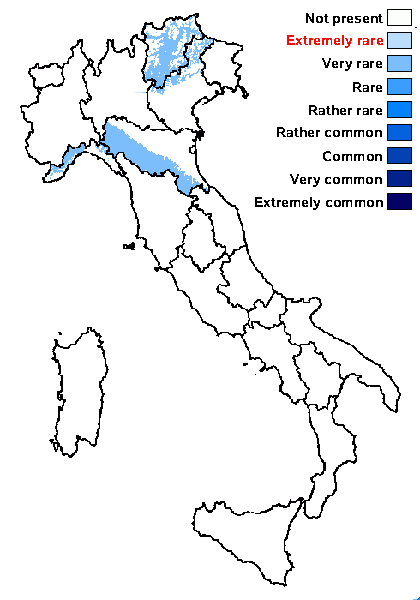
Predictive model
Herbarium samples
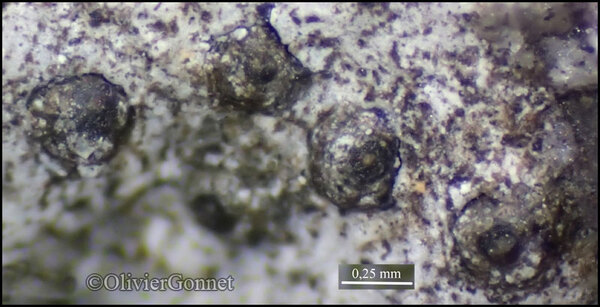
Courtesy Danièle et Olivier Gonnet - Source: https://www.afl-lichenologie.fr/Photos_AFL/Photos_AFL_V/Texte_V/Verrucaria_rupestris.htm
France, 4/9/2014 - Darois, Combe En Neudry, alt. 470 m - Côte-d'Or

Courtesy Danièle et Olivier Gonnet - Source: https://www.afl-lichenologie.fr/Photos_AFL/Photos_AFL_V/Texte_V/Verrucaria_rupestris.htm
France, 4/9/2014 - Darois, Combe En Neudry, alt. 470 m - Côte-d'Or

Courtesy Danièle et Olivier Gonnet - Source: https://www.afl-lichenologie.fr/Photos_AFL/Photos_AFL_V/Texte_V/Verrucaria_rupestris.htm
France, 4/9/2014 - Darois, Combe En Neudry, alt. 470 m - Côte-d'Or
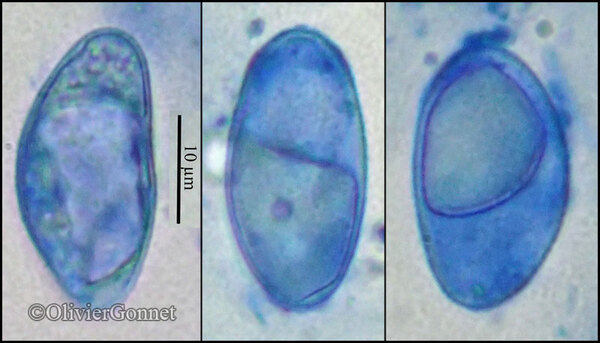
Courtesy Danièle et Olivier Gonnet - Source: https://www.afl-lichenologie.fr/Photos_AFL/Photos_AFL_V/Texte_V/Verrucaria_rupestris.htm
France, 4/9/2014 - Darois, Combe En Neudry, alt. 470 m - Côte-d'Or
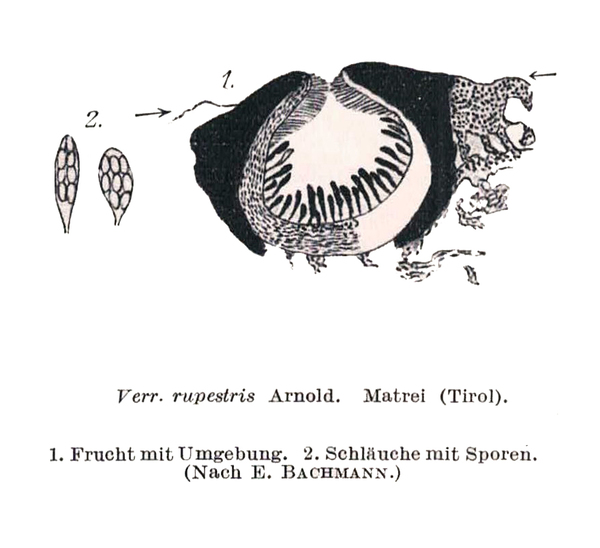
Zschacke, H. (1934) Epigloeaceae, Verrucariaceae und Dermatocarpaceae. In: Dr. L. Rabenhorst‘s Kryptogamen-Flora, Band 9, Abt. 1, Teil 1. Akademische Verlagsgesellschaft, Leipzig, 695 pp. - Public Domain
Growth form: Crustose
Substrata: rocks
Photobiont: green algae other than Trentepohlia
Reproductive strategy: mainly sexual
Pioneer species
Commonnes-rarity: (info)
Alpine belt: absent
Subalpine belt: absent
Oromediterranean belt: absent
Montane belt: very rare
Submediterranean belt: very rare
Padanian area: absent
Humid submediterranean belt: absent
Humid mediterranean belt: absent
Dry mediterranean belt: absent

Predictive model
| Herbarium samples |

Courtesy Danièle et Olivier Gonnet - Source: https://www.afl-lichenologie.fr/Photos_AFL/Photos_AFL_V/Texte_V/Verrucaria_rupestris.htm
France, 4/9/2014 - Darois, Combe En Neudry, alt. 470 m - Côte-d'Or

Courtesy Danièle et Olivier Gonnet - Source: https://www.afl-lichenologie.fr/Photos_AFL/Photos_AFL_V/Texte_V/Verrucaria_rupestris.htm
France, 4/9/2014 - Darois, Combe En Neudry, alt. 470 m - Côte-d'Or

Courtesy Danièle et Olivier Gonnet - Source: https://www.afl-lichenologie.fr/Photos_AFL/Photos_AFL_V/Texte_V/Verrucaria_rupestris.htm
France, 4/9/2014 - Darois, Combe En Neudry, alt. 470 m - Côte-d'Or

Courtesy Danièle et Olivier Gonnet - Source: https://www.afl-lichenologie.fr/Photos_AFL/Photos_AFL_V/Texte_V/Verrucaria_rupestris.htm
France, 4/9/2014 - Darois, Combe En Neudry, alt. 470 m - Côte-d'Or

 INDEX FUNGORUM
INDEX FUNGORUM
 GBIF
GBIF
 DOLICHENS
DOLICHENS
